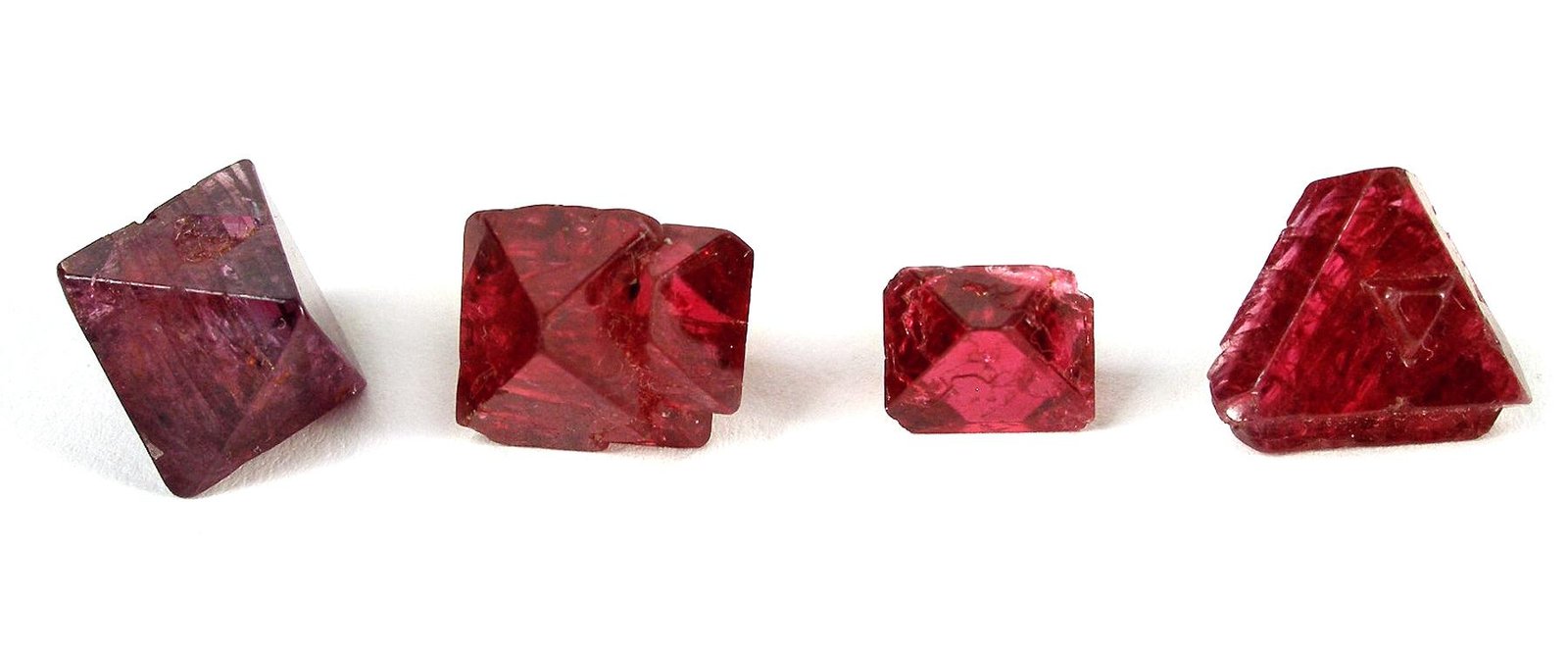


Spinel is a mineral that owes its beautiful color to chromium, much like rubies and emeralds do.
It has a hardness of 8 on the Mohs hardness scale (diamond has a hardness of 10).
Spinel is seen in a wide range of colors: red, lavender, violet, blue, green, brown, black.
Often, spinel is found in gravel deposits where there is much corundum as well.
Spinel typically contains magnesium and aluminum.
The chemical formula for spinel is MgAl₂O₄.
Spinel is singly refractive, often transparent, with a specific gravity of 3.60 and a refractive index of 1.718.
Spinel crystals have no true cleavage.

Chemical Formula: MgAl2O4
Color: Red, blue, black, gray, lilac, green, purple, brown, orange, orangish-red, colorless, and pink.
Crystal Structure: Isometric with octahedral crystals
Luster: Vitreous
Transparency: Mostly transparent but can be opaque
Refractive Index: 1.719 to 1.920, depending on the variety
Fracture: conchoidal
Durability: high
Dispersion: 0.020
Cleavage: None
Treatments: Naturally untreated, but can be heat treated
Inclusions: Rare, but sometimes silk, spangles, feathers, or swirls.

Below, we’ve outlined a quick list of the different types of spinel and their associated colors:
Spinel: Pure variety except for green and yellow spinel.
Picotite: A mixture of magnesium and chromium, seen in dark green to black spinel stone and brown spinel.
Galaxite: Manganese-rich variety in dark red spinel to black spinel.
Gahnite: Zinc variety in rich, dark green.
Ceylonite and Pleonaste: Intensely dark spinel varieties containing magnesium and iron traces
Hercynite: An iron variety in dark colors like black spinel, also called chromohercynite

Gahnospinel: A solid-state blended species combining spinel and gahnite to produce blue and dark blue varieties
Pleonast: Opaque spinels in colors like dark blue, green, and black.
Ruby Spinel: a translucent red gemstone (spinel)
Alexandrite Spinel: Grayish blue in daylight and violet in incandescent light
Natural spinel is not subject to enhancement due to the unique properties of these stones. However, some methods of growing synthetic crystals have been worked out. That is why we often come across synthetic spinel specimens on sale that are difficult to distinguish from real minerals of natural origin by standard diagnostic methods. When buying an expensive spinel, you should make sure you have an expert opinion issued by an independent gemological laboratory. The absence of beneficiation makes the spinel stand out among other gemstones.
We’ve already talked a lot about spinel colors and varieties, but now we’ll share the spectral color qualities used for identification purposes.
Thanks to their strong durability and hardness, spinel gemstones come in all shapes and sizes. With such high clarity and refractive index, the most popular cuts include round brilliant, emerald, cushion, and oval. Interestingly, spinels naturally have octahedral (eight-sided) crystals, and gem cutters will commonly cut the stones into octahedrons, which look like an eight-sided diamond shape, to best display the crystals.
Spinel has a high refractive index, meaning the light passes and leaves the stone brilliantly, making for a striking, sparkly stone when cut and polished. Spinel indeed encounters impurities, which in other gems can diminish the stone’s clarity. Spinel, however, only becomes more beautiful when interacting with elements. It’s the stone’s impurities that color it into a red, blue, orange, or even black variety.
While spinel stones are abundant in nature, you won’t come across them as frequently in the gem trade. Unfortunately, this is a result of their imposter-like qualities that associate them with rubies. That said, most gem-quality fine spinels are cut non-standard in weight. Doing this saves carat weight. Most fine-quality spinels are mixed-cut in oval shapes to standard sizes like 6x4 and 7x5 mm. These sizes lend themselves best to center stones used in fine jewelry rings. That said, the larger the carat weight, the higher the price-per-carat. The most prestigious spinels weigh five carats in colors like red, blue, and pink. Spinels can even weigh hundreds of carats, as seen in famous gemstones displayed in museums and royal jewelry archives.